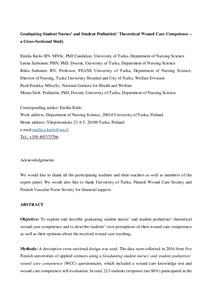Graduating student nurses' and student podiatrists' wound care competence: a cross-sectional study
Emilia Kielo; Leena Salminen; Minna Stolt; Pauli Puukka; Riitta Suhonen
Graduating student nurses' and student podiatrists' wound care competence: a cross-sectional study
Emilia Kielo
Leena Salminen
Minna Stolt
Pauli Puukka
Riitta Suhonen
MA HEALTHCARE LTD
Julkaisun pysyvä osoite on:
https://urn.fi/URN:NBN:fi-fe2021042827498
https://urn.fi/URN:NBN:fi-fe2021042827498
Tiivistelmä
Objective: To explore and describe graduating student nurses' (SNs) and student podiatrists' (SPs) theoretical wound care competence, as well as students' own perceptions of their wound care competence and their opinions about the received wound care education.
Method: A descriptive cross-sectional design was used. Data were collected from five Finnish universities using a graduating SNs and SPs wound care competence (WOO) questionnaire, which included a wound care knowledge test and a wound care competence self evaluation. Data were analysed statistically and with qualitative content analysis.
Results: A total of 213 students (response rate: 86%) participated in the study. Of these, 194 were SNs and 19 SPs. Students answered 48% of the knowledge test questions correctly (SNs 46%, total score 14/29; SPs 60%, total score 13/22). SPs' wound care competence was statistically significantly higher (p<0.0001) than that of SNs. Both groups self-evaluated their wound care competence to be deficient. Students who had more practical training in wound care during practical training periods scored statistically significantly better in the knowledge test. Students showed a positive attitude towards wound care by expressing an interest in it and acknowledging its importance.
Conclusion: Graduating SNs' and SPs' theoretical wound care competence is limited. The results showed that more wound care education, especially practical training, is needed in SNs' and SPs' education curriculums to adequately respond to the increasing needs in wound care.
Kokoelmat
- Rinnakkaistallenteet [27094]
